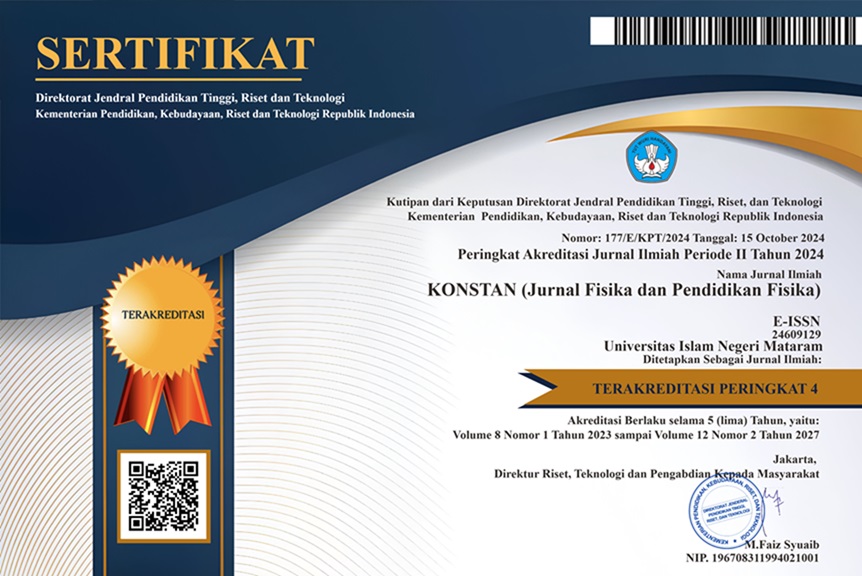The Effect of Variation in Number of Blades on Current and Voltage in Simple Waterwheel Props
Abstract
The world's dependence on fossil fuels has caused energy crises and environmental pollution, making renewable energy a crucial solution to develop. This study aims to analyse the effect of blade number variation on current and voltage in a simple waterwheel system. A quantitative correlational design was used to measure the relationship between the number of blades and the resulting electric current and voltage. The experiment used an educational water turbine generator kit, a digital multimeter, a stopwatch, a beaker, and supporting tools. The procedure involved three stages: assembling the turbine kit, measuring current and voltage across four blade variations, and calculating water flow using a beaker and stopwatch. Blade variations tested were 8, 6, 4, and 2, with each configuration measured four times for accuracy. The results showed a direct correlation between the number of blades and the generated current and voltage. Reducing the blade count from 8 to 2 resulted in a 19.05% decrease in current (from 13.02 A to 10.54 A) and a 52.63% drop in voltage (from 0.38 V to 0.18 V). A key challenge during the experiment was the fluctuating water flow rate, which made it difficult to maintain a perfectly constant flow. Therefore, the flow rate was approximated using the discharge formula and considered relatively stable. This experiment confirms that increasing the number of blades enhances energy conversion efficiency. In conclusion, mechanical energy directly influences electrical output, with blade number being a key factor. Future studies should explore variations in blade design, materials, and water flow control for optimal micro-hydro efficiency.
Downloads
References
[2] D. Corio, I. H. Tambunan, A. Aminur, and H. Yuliansyah, Optimalisasi Pembangkit Listrik Tenaga Surya di Daerah Kepulauan, vol. 1, no. Desember 2023. 2023.
[3] K. L. Pradisha, H. Bugis, and D. S. Wijayanto, “Pengaruh Jumlah Sudu Terhadap Daya Dan Efisiensi Turbin Air Crossflow Untuk Pembangkit Listrik Tenaga Pico Hidro,” NOZEL J. Pendidik. Tek. Mesin, vol. 5, no. 2, p. 93, 2023, doi: 10.20961/nozel.v5i2.72139.
[4] M. Idris, I. Hermawan, and B. H. Simamora, “Analisis Kinerja Kincir Air Tipe Undershot Bahan Aluminium Dengan Jumlah 10 Sudu dan Sudut 200,” IRA J. Tek. Mesin dan Apl., vol. 1, no. 3, pp. 37–43, 2023, doi: 10.56862/irajtma.v1i3.32.
[5] V. Rinanda and R. Permatasari, “Optimasi Desain Turbin Air Tipe Vortex Dengan 5 Variasi Jumlah Sudu Terhadap Efisiensi,” Semin. Nas. Cendekiawan ke 4 Tahun 2018 Buku 1 ”Teknik, Kedokt. Hewan, Kesehatan, Lingkung. dan Lanskap“, vol. 4, no. 4, pp. 785–790, 2018, [Online]. Available: https://www.event.lemlit.trisakti.ac.id/semnas/article/view/3543
[6] A. Buku, B. Tangaran, and C. P. H. Tiyow, “ANALISIS VARIASI JUMLAH SUDU PADA KINCIR AIR ARUS BAWAH SEBAGAI TENAGA IRIGASI SKALA LABORATORIUM,” Pros. Semin. Nas. Penelit. dan Pengabdi. Masy., vol. 2019, pp. 204–209, 2019.
[7] N. Nurhaswinda et al., “PENELITIAN KORELASI,” vol. 4, no. 2, pp. 2644–2655, 2025, [Online]. Available: file:///C:/Users/min1j/Downloads/Meynita+Pratasya.pdf
[8] Hilma and A. Malik, “Analisis Pengaruh Tegangan dan Hambatan Terhadap Kuat Arus dengan Menggunkan Phet Simulation,” JFT J. Fis. dan Ter., vol. 10, no. 2, pp. 76–85, 2024, doi: 10.24252/jft.v10i2.39275.
[9] Ratna Mustika Yasi and Charis Fathul Hadi, “Pengaruh Tegangan Terhadap Besar Kuat Arus Listrik Pada Persamaan Hukum Ohm,” J. Zetroem, vol. 3, no. 1, pp. 34–36, 2021, doi: 10.36526/ztr.v3i1.1331.
[10] P. Aboutalebi, A. J. Garrido, I. Garrido, D. T. Nguyen, and Z. Gao, “Hydrostatic stability and hydrodynamics of a floating wind turbine platform integrated with oscillating water columns: A design study,” Renew. Energy, vol. 221, no. August 2023, p. 119824, 2024, doi: 10.1016/j.renene.2023.119824.





